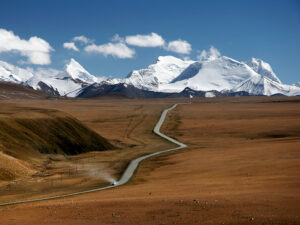K2 climbers are jamming Camps 2 and 3 and the rope-fixing team continues to struggle above Camp 4. They will need to summit tomorrow, before their clients ran out of patience, stamina, and especially oxygen.
Summit chances narrowing
“Today more than 50 climbers reached Camp 3 for their final summit push,” Pioneer Adventure reported.
Camp 2 is apparently crowded as well. All hopes rest on a forecast improvement in the weather tomorrow, but the pressure is increasing because of crowding, limited (although huge) oxygen supplies, relentless bad weather, and in some cases, climbers in a hurry.

Climbers at House’s Chimney on K2. Photo: Seven Summits Club
The rope fixers have reached Camp 4 and they may be trying to continue further, but at present, there is no summit news. Each delay creates a logistical issue for oxygen-dependent clients. Most probably, the sherpas will fix as they go, with a large number of climbers in tow.
Teams push from Camp 3 to summit
Silvia Azdreeva, a client with EliteExped, wrote on Instagram that her team has been at Camp 3 for two days, “waiting for better weather.” And, presumably, for the rope fixers to complete their job. They will set off on their summit push tonight.
Kristin Harila and her team left Camp 2 (at a remarkably fast pace, according to her tracker) and reached Camp 3 this afternoon. The rest of Seven Summit Treks peak baggers are doing their best to keep pace. They include 17-year-old Nima Rinji Sherpa, Uta Ibrahini of Albania-Kosovo, and Allie Pepper of Australia.
Climbing with Lakpa Sherpa, Pepper’s group is at Camp 3 (7,400m). They will leave for the summit tonight. Pepper summited Broad Peak without supplementary oxygen some days ago. According to one of her previous posts, she aims to summit all 14 8,000’ers in the same way. It is unclear, however, if she will manage to do this on K2.

Kristin Harila, left, and Allie Pepper in Base Camp two days ago. Photo: Allie Pepper/Instagram
Unpredictable weather
Several climbers have noted that weather forecasts have been inaccurate. Skies were supposed to clear today, for example, but that has not happened.

Porters manage oxygen supplies at Camp 3 on K2. Photo: Summit Karakoram
Paraglider Richard Barber has just returned from the Baltoro area with some interesting comments about weather predictions. “I found out that the soaring forecasts were an excellent way to understand what was going on and how inclement the weather was,” he told ExplorersWeb.
He referred to the weather models used to predict thermal conditions, an essential tool for paragliders and hang gliders.
If you open this link, you’ll see the Baltoro area divided into color blocks. If you click on any of the blocks, you’ll get an option for a Meteogram showing the temperature, freezing altitude, and cloud type.
“We found that if there were any vertical lines at all, that basically meant it was going to be stormy and there’d be rain/snow,” Barber noted.
Here is K2’s Meteogram for the next few days:

Soaring Meteo’s chart for K2.
According to Barber’s experience, every time they saw a prediction for rain, it really rained — a lot. The current chart, above, shows precipitation every day until at least next Wednesday, with a heavy storm on Friday and Saturday.
The ordinary multimodel charts show an equally pessimistic panorama:

Weather forecast for the summit of K2 by meteoexploration.com.
Why this is such a dangerous summit push
Teams out of time. This year, bad weather has delayed the rope fixing, and with it, the option for teams to distribute their summit attempts over several days. With August just around the corner, it’s “tomorrow or never” for most. Yet conditions are poor — lots of heavy snow in the last few days, the rope-fixing team said — and the weather remains uncertain.
Low start — longer summit day. Starting a summit push from Camp 3 forces the climbers to endure a longer journey — 1,200 vertical meters over steep terrain. They will have to deal with the Bottleneck and the traverse below the Great Serac (the most dangerous part of K2’s Abruzzi Spur route) later in the day. This is when conditions become more hazardous. Moreover, all teams seem to be aiming to summit tomorrow. This will increase traffic jams at those upper (and most exposed) sections.
The recent experience on Nanga Parbat has shown that climbers starting from Camp 3 — even those on oxygen — need every last gram of strength to return safely from the summit. K2 is 600m higher than Nanga Parbat, and nearly all the climbers currently heading up must have suffered from the long stay in Base Camp or from previous climbs on Pakistan’s 8,000’ers.

Climbers queue on their way to Camp 3 today. Photo: Sajid Sadpara
The long descent. Finally, it is unclear whether they will find space in a tent on their way down, assuming they intend to stop at all. In recent years, many oxygen-supported clients downclimb all the way back to Base Camp after summiting, a grueling effort lasting well over 24 hours.






